Delicious, low-calorie and high in fiber, traditional Japanese konjac jelly with fruits is almost the perfect gluten-free, vegan dessert for those on a diet. It's extra refreshing in the summer! (GF) (Vegan)
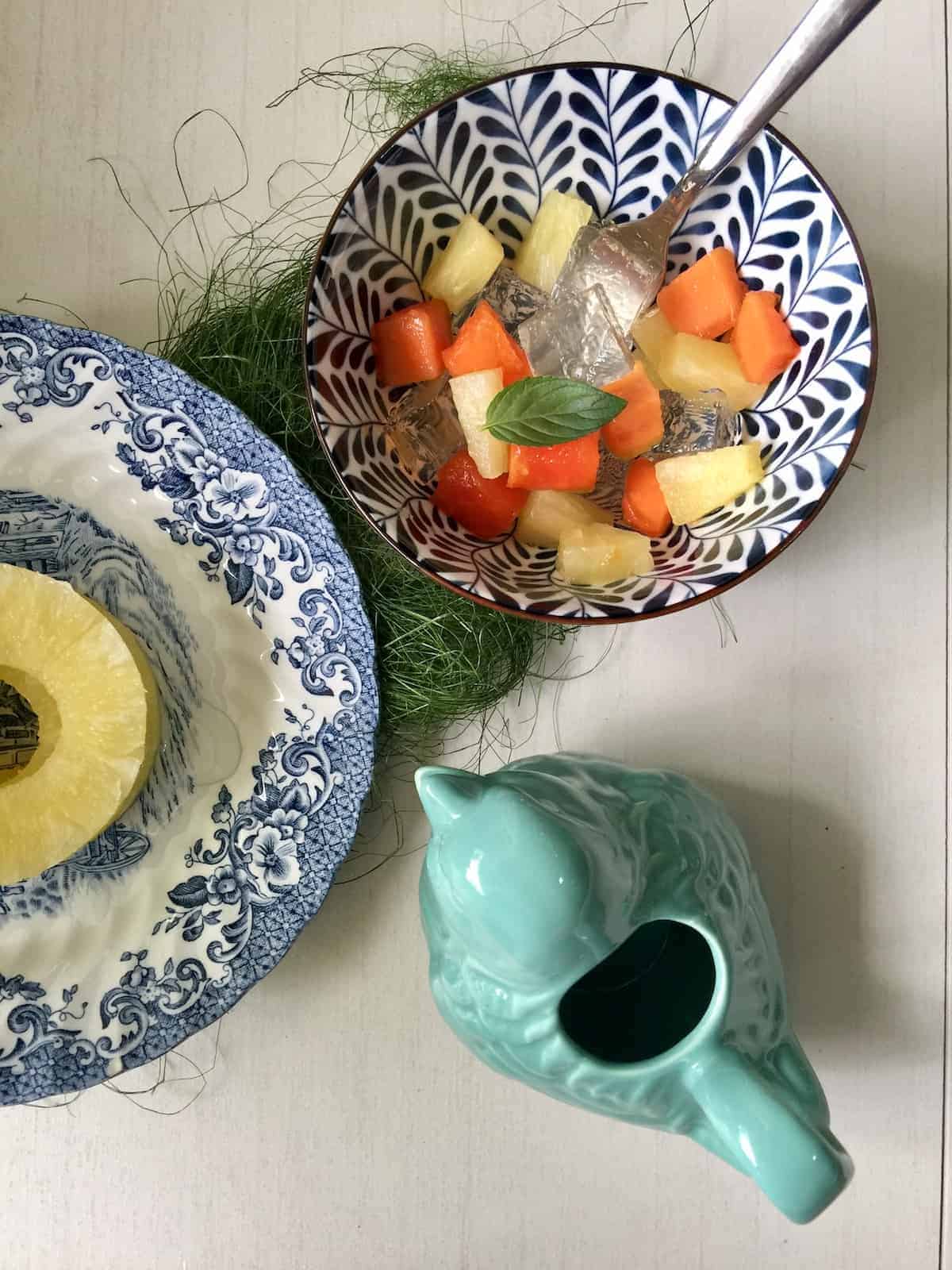
Jump to:
Why Make This
- It's a healthy dessert snack: because of the fruits, we don't need to add sugar. If you really, really want more sweetness, add coconut water to the powder instead which is naturally sweet. This has been eaten by the Japanese since the sixth century- it is a great alternative to sugary snacks!
- Versatile: For variety, switch up the fruits: you can even use your leftover Japanese plums from making ume-shu, yuja-cheong, maesil-cheong, or tangerine cheong. (By not adding the fruits into the jelly, you extend the time it can be kept.)
- A quick dessert that's perfect for summer: Konjac jelly is 1 of my favourite zero sugar desserts because it's delicious, cooling and also quite good for one's diet (if you don't add too much sugar, it has low calories.)
Note: For other konjac jelly recipes, visit Chinese sour plum jellies, yuzu konnyaku jelly, osmanthus konnyaku jelly with goji berries and champange lychee jelly. They're great desserts to serve with sashimi and sushi!
What is Konjac Jelly
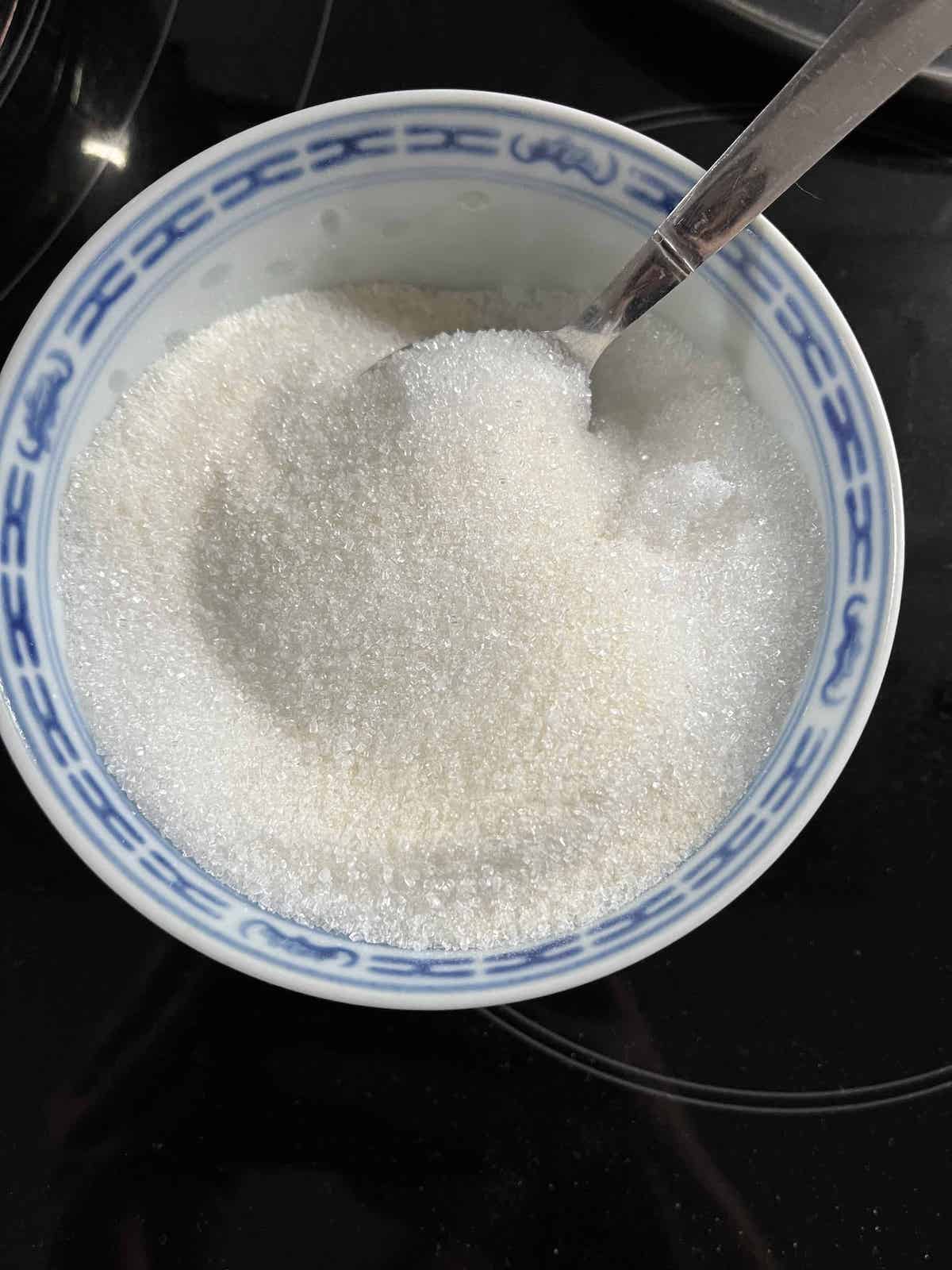
Also known as konnyaku jelly, konjac jelly is a Japanese jelly that has been part of the cuisine for many years.
Because it is high-fibre, low-calorie, and vegan, it's traditionally incorporated into the diet when someone is trying to lose weight.
In fact, it can even be used to replace fat in meat and dairy products! When introduced to various parts of Asia in the 80s and 90s, this sweet dessert was an instant hit and there were many cooking classes devoted to making this jelly snack.
Fun fact: it is made from the konjac bulb but not all konjac bulbs can solidify into jelly! Other names include Amorphophallus, konnyaku konjaku, devil’s tongue (Nice!), snake palm, elephant yam and voodoo lily.
IMPORTANT: Konjac jelly has a very chewy texture so it doesn't dissolve in the mouth- it can absorb up to 200x its weight in water! Because of this, konnyaku jelly can bea harmful choking hazard and has been banned in countries such as Australia in recent years. (Kids have choked to death on it before.) So be very careful when eating konjac jelly or sipping on konjac jelly drinks. Chew a lot and don't serve it to the young and old!
Health Benefits
Konjac jelly is good for your health in various ways:
- Improves the immune system
- Full of dietary fiber and good for the digestive system/ bowel movements
- Promotes weight loss and effective against obesity
- Reduces blood cholesterol
- According to Japan External Trade Organization, it is also good for healthy skin (Hence all the dietary supplement products such as drinkable konjac jelly with vitamin C etc- many of these products are loaded with sugar, so be careful!)
Note the above info is from ScienceDirect and not meant as nutritional, dietary or health advice. MedicalNewsToday has an even longer list of konjac's health properties so click the link if you're interested.
Note that some people have reported intestinal blockages so remember to check with your doctor before making changes to your diet.
Ingredients
You only need a few simple ingredients for this jelly recipe:
- the jelly: You can get it in 2 forms. One is ready to eat jelly. This is either sweetened, and packaged in small bite-sized servings (often with artificial chemicals, preservatives and a ton of sugar) OR unsweetened and tasteless. The former is a sweet treat and the latter used in savoury dishes such as miso dengaku (I have to be honest and say that such dishes may be a bit of an acquired taste if you're not used to Japanese food.) What we want is the jelly powder, which we'll add to the boiling water to turn into a dessert. Some packets have sugar included and others don't. I am using konnyaku powder with no sugar added for this recipe. (If you decide you want to add sugar, add the sugar to the powder and mix well BEFORE adding it to the water as the powder will clump like crazy after getting wet.) See below for konnyaku powder alternatives.
- Water: The amount you need depends on how much konnyaku powder you use. Check the back of your packet for the amount required.
- Fruits of choice: I like to use whatever is in season
- Mint leaf: optional garnish. I get mine from my Click & Grow indoor planter!
Note: if you want actual konjac fruit jellies- where the jelly tastes of fruit- you can popular flavors such as peach flavor to the jelly before it sets.
Likewise, the color of the jelly is naturally a translucent grey, but you can add coloring if you want it to be a different color.
Substitutes
Other gelling agents you can use are:
- gelatine (not vegan): The texture of konnyaku jelly is much firmer than gelatine- it does not wobble! Also, gelatine-jellies need refrigerating to set.
- Agar agar (made from seaweed so also vegan/ 100% plant based): konjac jelly is springier, with a bouncy texture, and more difficult to cut through. (For more info on agar agar, click this link and this one to see what can be used instead of agar agar.) Another thing to note is that agar agar and konjac can set at room temperature in the tropics (where it's like 30C/ 86F), although it's best to leave them in the fridge to set! This makes it very handy when you want to create fun jellies such as this easy koi fish dessert.
Storage
The konnyaku powder can be kept in an airtight container, at room temperature, in a cool, dark place (away from direct sunlight.)
Once made into Konjac Fruit Jelly, do not freeze as the texture will change! Store the jelly in the fridge for 3-5 days.
Troubleshooting
The common issues people have with the powder include:
- clumping: lumps form very quickly on contact with water so it's best to whisk the powder with sugar first (if using.) Add the konnyaku powder- sugar mixture slowly to the liquid and whisk furiously at the same time when making Japanese fruit jelly
- liquifying: click here for reasons why konjac jelly liquifies
- reading the packet wrongly and adding too much/ little water/sugar: click here for troubleshooting help
- We need konnyaku powder to make jellies, as konjac powder in some countries will need an alkali to solifidy.
Frequently Asked Questions
On its own, konjac is pretty tasteless (neutral flavour.) Thus, it's very suitable for savoury and sweet applications, such as:
- Osechi: the konjac is braided and added to the japanese dish nishime (simmered with vegetables and maybe chicken or pork)
- Oden: round konjac balls are put in hot pot
- "Sashimi konjac": seasoned with yuzu-miso, wasabi-soy or vinegar-soy
- Stir-fried with miso and/or other ingredients
- Pasta substitute: shaped into long thin strips (like long noodles) and added to soup, stir-fries or sukiyaki (it absorbs the sauce wonderfully)
- For dieting and weight-loss: Konjac is shaped as grains and cooked with rice
Besides culinary applications, it is also used in other industries such as pharma drugs, facial sponges, and even massage equipment!

Other Jelly Recipes
Enjoyed this easy Konjac Jelly Recipe? Please leave a 5-star 🌟🌟🌟🌟🌟rating in the recipe card below! If you REALLY liked this summer dessert, please consider supporting it by buying me a packet of konjac powder ! 🙂 (No obligation though!) Thank you and have a great day!
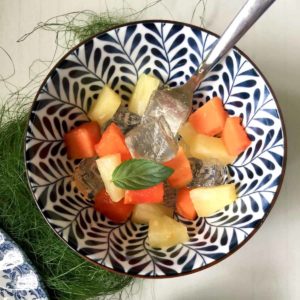
Japanese Konjac Jelly with Fruits (Vegan) (GF)
Equipment
- Pot
- Heatproof whisk
- Knife
Ingredients
- Fruits of choice, cut into ½ inch/1.25cm cubes- I suggest using as much fruit as jelly (so if your packet of konnyaku powder calls for 1 litre of water, use 2.2 lb/ 1 kg of fruits) A mix of citrus fruits is great- oranges, pineapple, mango and kiwi- but I usually just use whatever I have on hand!
- Konnyaku Powder Preferably choose ones with no sugar added. The recipe works even if the packet has sugar added, but it's not so good for weight loss in that case!
- Water, amount depends on the packet of konnyaku powder you're using- check the instructions for the required quantity but it's usually 1litre If you really need some sweetness, use coconut water which is naturally sweet- the instructions are exactly the same whichever you use.
- Mint leaves, optional for garnish
Instructions
- Cut the fruits into ½ inch/ 1cm cubes and put in the fridge to chill.
- Make the konjac jelly according to the instructions on the back of the packet. If you need more tips, check out these osmanthus jelly and yuzu konnyaku jelly links. Key things to note are to keep stirring continuously- if not you'll get a very lumpy, uneven jelly, let the mixture of powder and water boil for about 5 minutes (or till the bubbles disappear) then cool. (Keep stirring as long as the pot is boiling.)
- After that, pour the jelly into a large heat-proof container. We don't want the liquid to be more than ½ inch/ 1.25 cm high (as we'll be cutting the jelly into ½ inch/1.25 cm cubes), so if your container isn't large enough, pour the extra liquid into another heat-proof container to set.
- Let the jelly cool for about 3h, preferably in the fridge. When mine is too full, I just leave it outside and it still sets (room temperature: 30c/86f) The dessert tastes nicer cold though.
- Once firmed up, cut the jelly into ½ inch/ 1.25cm cubes.
- Mix approximately an equal number of jellies and fruit cubes per bowl, (optional) garnish with a mint leaf and serve. If you have guest who have really sweet teeth, you can offer them some syrup or honey to pour onto the jelly whilst you have your tasty, healthy, low-calories, no sugar added dessert!
Notes
Note: the nutritional information is an estimate automatically calculated using the WPRM recipe maker and I am not responsible for its veracity.
If you have questions about how to use konjac jelly, let me know in the comments!

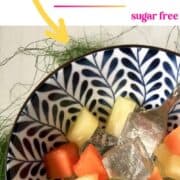
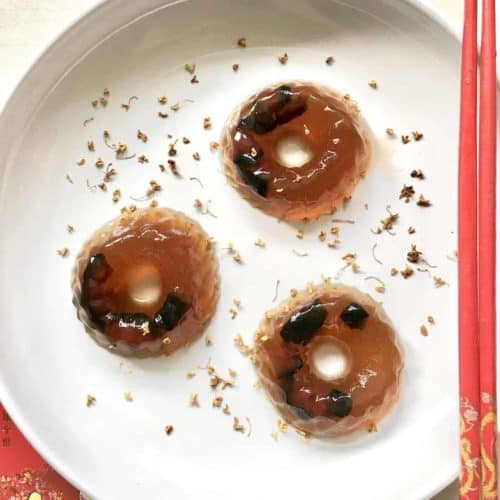
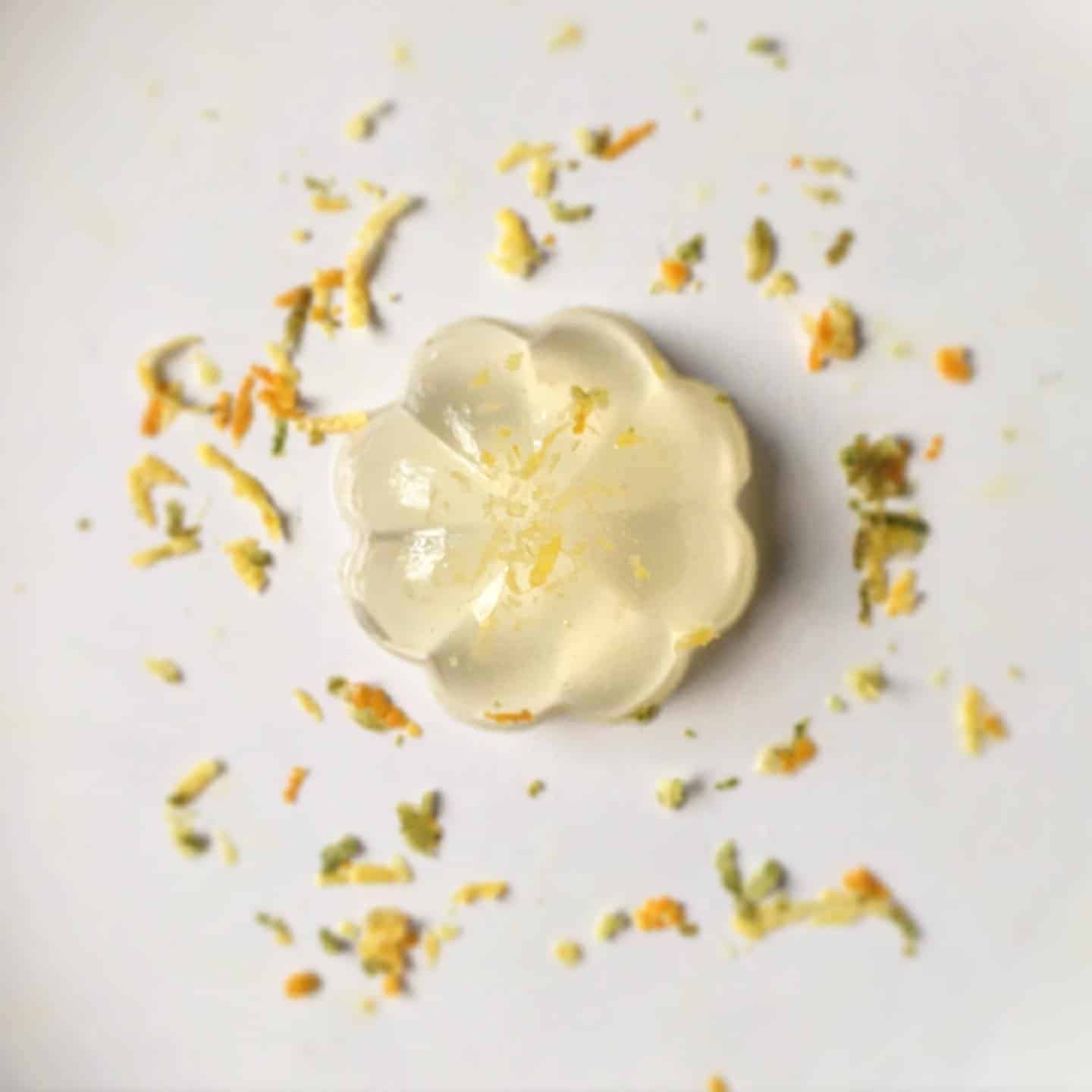
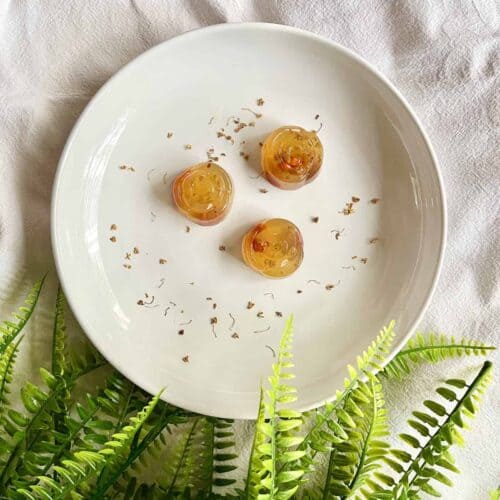
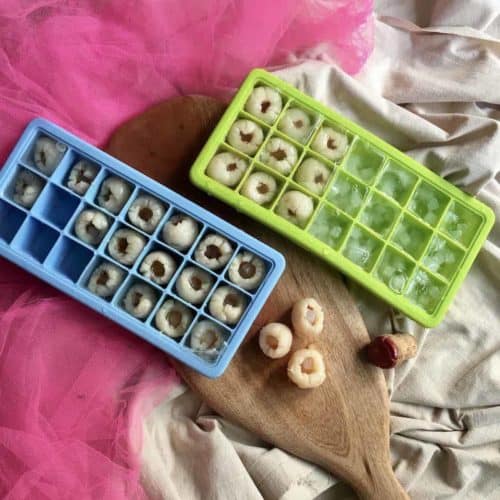
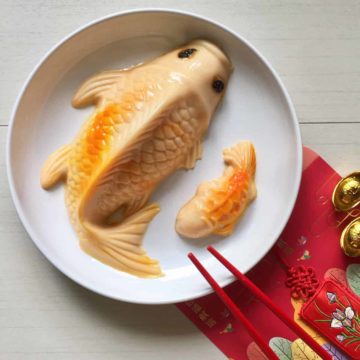
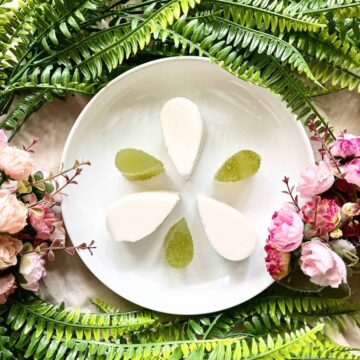
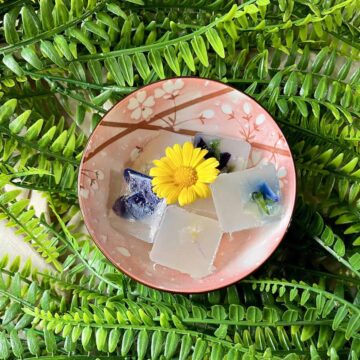
Eliane says
This recipe is somewhat incorrect.
There is a BIG BIG difference between Konjac powder, Glucomannan powder and Konyakku powder.
Konyakku powder is what you need to use for this recipe. It is a mixture of gelatinizing ingredients that include Konjac in the mixture.
If you try to use just konjac powder, this recipe will not work. konjac powder needs an alkali to solidify. Glucomannan is the isolated polysaccharide from the konjac root, this powder will not work for this recipe either. It also needs an alkali to solidify.
Zen says
Thanks for the clarification Eliane 🙂 (We actually sell the powder for the jelly as Konjac Powder sometimes, where I live, but I've changed the post accordingly to make sure it's not confusing for people who live in other countries.)
Dani says
Hi what Konjac powders are available that have no sugar ? Can you please link some? I can’t find any that have no added sugars
Zen says
Hello Dani! May I know what country you're from? As different countries would have different brands available to them 🙂 Once I know, I'll add the links to the ones that are sugar-free! 🙂
Zoe says
I ordered Konjac powder from amazon and I am having a hard time making a jelly. It keeps coming out as a gummy sticky paste. What am I doing wrong? Should I be adding less water?
https://www.amazon.com/Konjac-Glucomannan-Non-GMO-Gluten-Free-Certified/dp/B074B6BCHM/ref=sr_1_7?crid=3UMJ4NCHLQWP1&keywords=konjac+powder&qid=1655958189&sprefix=konjac+powder%2Caps%2C136&sr=8-7
Is this an appropriate product? I want to make a konjac jelly drink using your recipe.
Zen says
Hi Zoe thanks for stopping by! I've not used the brand in question before, and the page doesn't give a specific ingredient breakdown, but from what I can see, it seems to be more geared towards use as a gum (konjac is sometimes used in place of xantham gum or cornstarch) and not a jelly. I recommend looking for a product that says "konjac jelly" instead. PS If making a konjac jelly drink, remember to be very careful with the size of the jellies/ chewing as the jelly is a choking hazard!
sam says
I want to do this recipe! do you know where online I could get the powder?
Zen says
Amazon! 🙂
Madison says
I'm not sure where to buy packets - if I purchase Konjac powder, how much should I use?
Zen says
Hello Madison! It would depend on where you live- most Asian grocery stores sell them or, if not, hop over to Amazon 🙂 The amount of powder to use would depend on the brand of Konjac powder you are using- different brands have different specifications so have a different weight: water ratio (as some include sugar, some do not etc etc) Have fun with this easy dessert!
yeni says
It's getting hot here so I made this over the weekend and it was great even without syrup! thanks
Zen says
Hi Yeni glad you liked this no sugar dessert! Will be sharing more jelly recipes soon since the weather is getting hot!